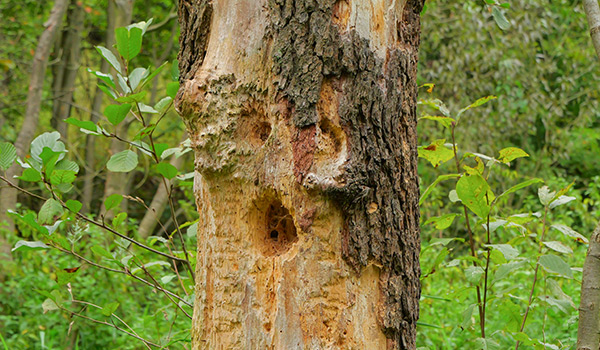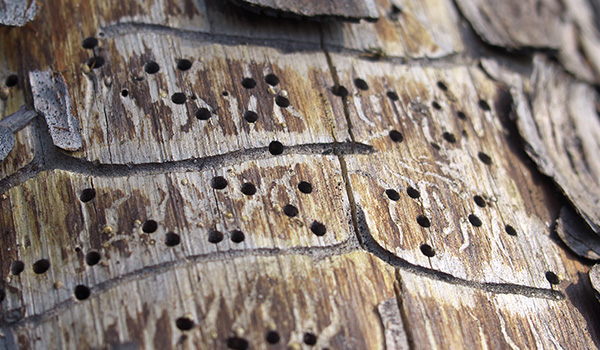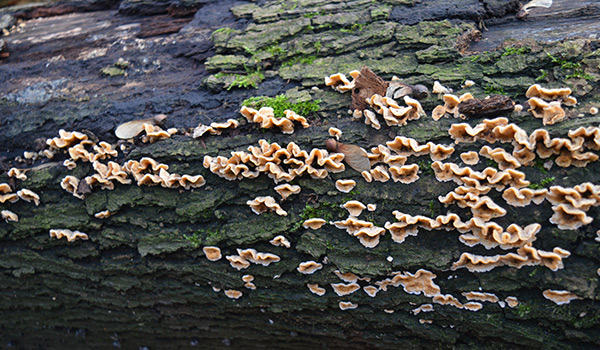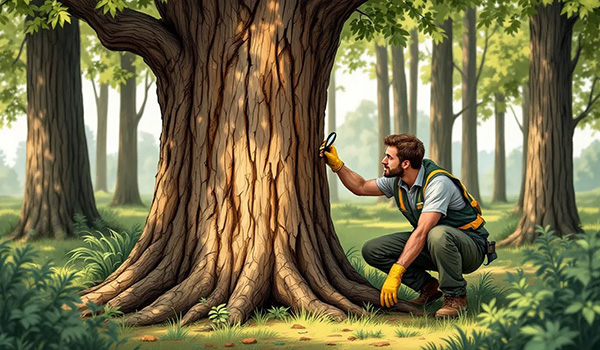Is your tree’s bark peeling? Learn when this is a natural occurrence and when it could signal a problem.

Key Takeaways
- While bark peeling can be a natural growth process in particular tree species, it’s essential to keep an eye out for indicators of stress or disease.
- Common causes of bark peeling include environmental stress, pest infestations, diseases, and physical damage, all of which require early recognition and intervention.
- Consulting a certified arborist is advisable for diagnosing serious issues and determining appropriate care strategies when bark peeling is observed.
When Bark Peeling Is Normal
Bark peeling is not always a cause for concern; for some tree species, it is a natural and healthy process. Trees like the shagbark hickory, river birch, and sycamore are known for their distinctive peeling tree bark that peels off in large, attractive sheets or flakes. The river birch, for instance, is celebrated for its exfoliating bark that curls and reveals smooth, attractive surfaces underneath, including exposed wood. This natural shedding bark allows the tree to grow and thrive by getting rid of old, dead bark and making way for new, healthy layers, which can also be described as shed bark.
Bark peeling in healthy bark trees often indicates vigorous growth and renewal. As the tree expands, the outer bark, serving as a protective layer, naturally cracks and sheds. This is particularly common in thin-barked trees and younger bark trees, where the outer layer can loosen bark pieces and fall away to accommodate growth, revealing the healthy bark underneath the tree’s bark, with bark falling in the process and bark cracking occurring as well. Additionally, the presence of older bark can also be observed in some trees, and loose bark peels can be found as part of this natural process.
This process is a natural process of perfectly normal growth as long as the tree’s inner tissues remain undamaged and show no signs of stress or disease.
Common Causes of Bark Peeling
Although natural shedding is harmless, other causes of bark peeling may indicate underlying issues needing attention. Common contributors to bark loss include:
- Environmental stress
- Pest infestations
- Tree Diseases
- Physical damage
Recognizing these causes early can help you take appropriate action to protect your trees from bark shedding.

Causes of bark peeling in trees include:
- Drought, extreme weather, and poor soil conditions that stress trees
- Infestations by bark beetles and other boring insects that damage the bark and inner tissues
- Fungal infections that weaken the bark and cause it to peel away
- Physical damage from lawn mowers, animals, and other mechanical sources, resulting in bark peeling and exposure of inner layers
Environmental Stress
Environmental stress significantly contributes to bark peeling in trees. Prolonged drought or extreme weather can cause the outer bark to crack and peel away. Trees, especially fruit and nut varieties, are particularly susceptible to drastic temperature fluctuations, which can result in bark damage and peeling.
Intense sunlight can cause sunscald, leading to bark peeling. To support tree health and prevent bark damage, consider the following:
- Apply mulch around the tree base to help maintain soil moisture and protect roots from extreme temperatures.
- Deep water the tree during dry periods.
- Improve soil drainage.
Pest Infestations
Pests like bark beetles and other insects can cause significant damage, leading to bark peeling as they bore into the inner layers and disrupt nutrient flow. Commonly infested trees include oak and pine species, which are particularly vulnerable to these pests.
The Emerald Ash Borer is notorious for causing severe bark splitting and dieback in ash trees. Signs of infestations include oozing sap, tiny holes, and fungus mats beneath the peeling bark and inner bark.
Treating promptly with insecticides like Carbaryl (Sevin) can protect trees from further damage. For severe infestations, consulting a certified arborist is recommended.
Diseases
Fungal diseases often cause bark peeling by weakening the bark, leading to further damage. Symptoms of fungal infections include dark lesions and discolored patches on the bark, which may indicate the presence of fungus beneath the surface.

Early treatment is crucial to prevent further spread. Removing diseased bark debris and pruning blackened bark can help contain the infection. Topical treatments like Bordeaux paste and fungicide sprays are effective when applied early.
Regular monitoring and prompt action are vital for maintaining tree health.
Physical Damage
Physical damage from mechanical sources or animals can cause bark peeling. Examples include:
- Lawn mowers
- Weed trimmers
- Other garden equipment
These tools can strip bark, especially at the tree base. Young trees with thin bark are particularly vulnerable.
Methods to protect trees from damage include:
- Wrapping the trunk with hardware cloth or installing tree guards to protect the tree from mechanical damage.
- The use of burlap or commercial wraps to protect trees from frost and sunscald during winter.
- Using deterrents to keep animals away and prevent further damage.
Identifying Serious Issues
Recognizing when bark peeling indicates serious health issues is crucial for timely intervention. Symptoms and conditions signaling underlying problems include:
- Dead branches
- Discolored leaves
- Early leaf drop
- Bark peeling caused by excessive heat or frost (which may require professional assessment)
Signs of mechanical injury or disease include:
- Cankers
- Sap oozing
- Unusual bark patterns
- Girdling (loss of bark all around the trunk, which disrupts nutrient flow and poses a severe threat to tree health)
Action steps if you notice these symptoms:
- Act quickly to determine the cause
- Take appropriate measures to address the issue
Steps to Take When You Notice Bark Peeling

When noticing bark peeling, evaluate the situation to support your tree. First, assess the damage to understand the extent and possible causes of bark loss. This helps determine the appropriate action, whether addressing environmental stress, treating pest infestations, or managing diseases.
Proper care and protection are crucial for the tree’s recovery. Timely intervention and consistent care significantly impact tree health and longevity.
Assess the Damage
Inspect the trunk and branches for signs of peeling bark, cracks, insect activity, or other signs of stress. Look for stress indicators like wilting leaves or early leaf drop, suggesting pests or diseases.
Understanding the extent of damage helps implement the proper measures for tree recovery.
Provide Proper Care
Proper care is vital for trees with peeling bark. Key steps include:
- Ensure timely supplemental irrigation, especially for young trees with injured bark.
- Provide deep, consistent watering.
- Use organic mulch to help retain moisture and support tree health.
Applying a balanced, slow-release fertilizer or compost tea aids tree recovery, but avoid over-fertilizing. Pruning damaged bark and trimming loose or dead bark improves airflow and promotes healing.
Regular monitoring and proper care are essential for overall tree health.
Protect the Tree
Protecting the tree from further damage is vital. Wrap tree trunks with light-colored tree guards to prevent sunscald and temperature fluctuations. Applying white or flexible latex paint reflects sunlight and minimizes peeling.
Install hardware cloth or sheet metal to protect bark from animals, and use barriers or deer deterrents for young trees. These preventive measures ensure long-term tree health and vitality.
Consulting an Arborist

When in doubt, consult a certified arborist. Arborists have the expertise to diagnose and treat tree issues related to bark peeling. If unsure whether bark loss is natural or a sign of decline, an ISA Certified Arborist can evaluate and recommend treatments.
In cases of severe damage, restoration methods like cabling, bracing, or removal may be necessary. An arborist can also evaluate trees impacted by events like lightning strikes to determine the best action. Their professional insight is invaluable for maintaining tree health and safety.
Bark Peeling Off Tree Summary
In summary, understanding the causes of bark peeling is crucial for maintaining the health of your trees. While some trees naturally shed their bark as part of their growth process, other causes like environmental stress, pest infestations, diseases, and physical damage require prompt attention.
By assessing the damage, providing proper care, and taking preventive measures, you can support your tree’s recovery and ensure its long-term health. When in doubt, consulting a certified arborist can provide the professional guidance needed to address more complex issues. Stay vigilant and proactive in your tree care to enjoy the beauty and benefits of healthy trees for years to come.
Tree Bark Frequently Asked Questions
Is bark peeling always a sign of disease?
Bark peeling is not always indicative of disease, as some tree species naturally shed bark during growth. However, if accompanied by signs of stress, pests, or other issues, it may suggest a problem that requires attention.
What should I do if I notice bark peeling off my tree?
If you notice bark peeling off your tree, first assess the damage and look for signs of stress, pests, or disease. Providing proper care—such as deep watering and mulching—can support your tree’s recovery, and consulting a certified arborist is recommended if you’re unsure about the best treatment.
How can I protect my tree from further bark damage?
To protect your tree from further bark damage, consider using light-colored tree guards or wraps to prevent sunscald and temperature fluctuations. Additionally, applying reflective latex paint and installing hardware cloth or sheet metal can protect against animal damage.
Are there specific pests that cause bark peeling?
Bark beetles, particularly the Emerald Ash Borer, are known to cause significant bark peeling in trees. Signs of infestation include oozing sap, tiny holes, and mats of fungus beneath the peeling bark.
When should I consult an arborist about bark peeling?
You should consult an arborist if you are uncertain whether the bark peeling is a natural occurrence or indicative of a more serious problem. Their expertise will help diagnose the issue and provide necessary treatment recommendations.